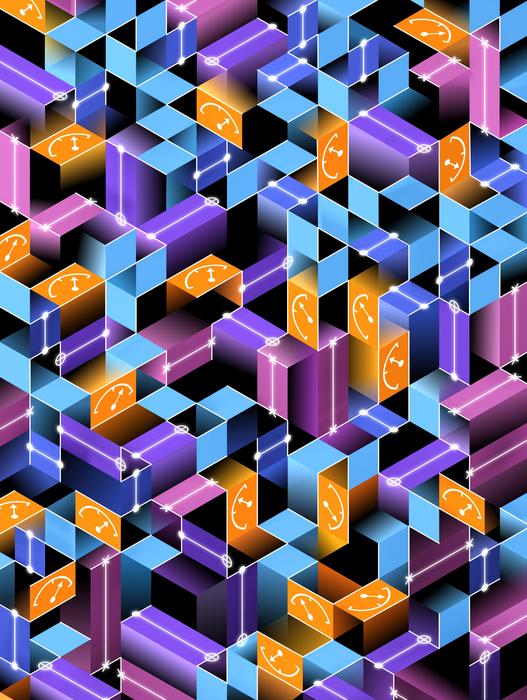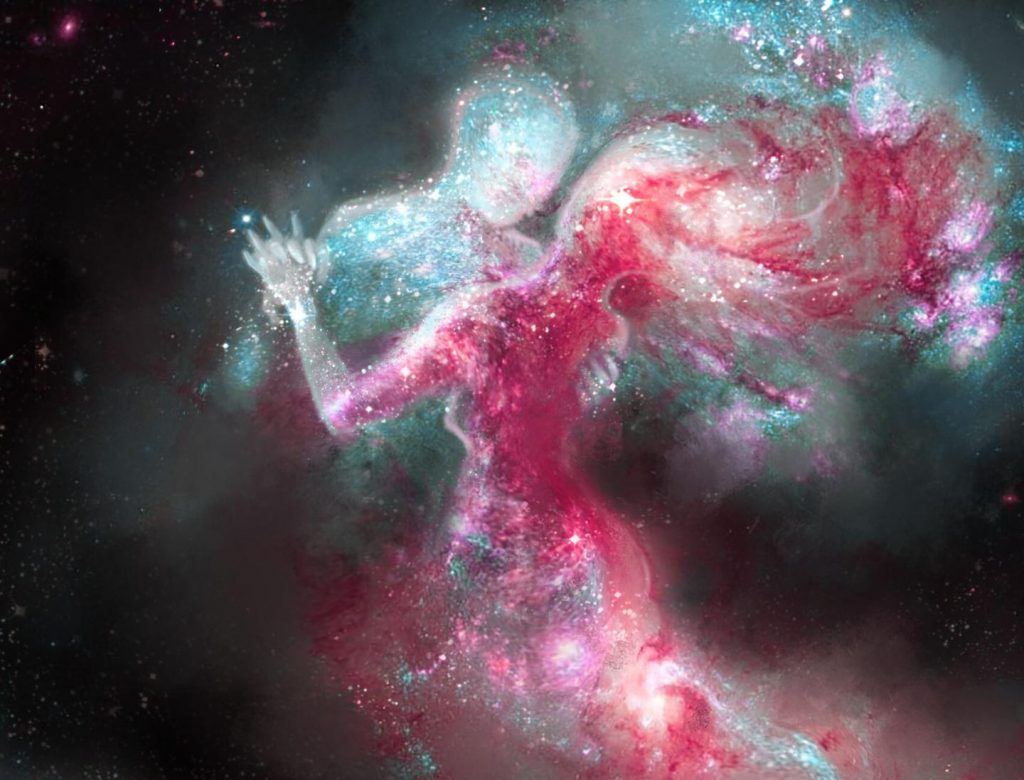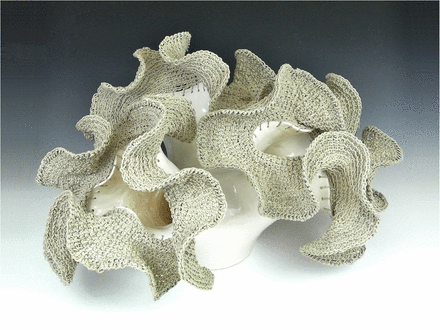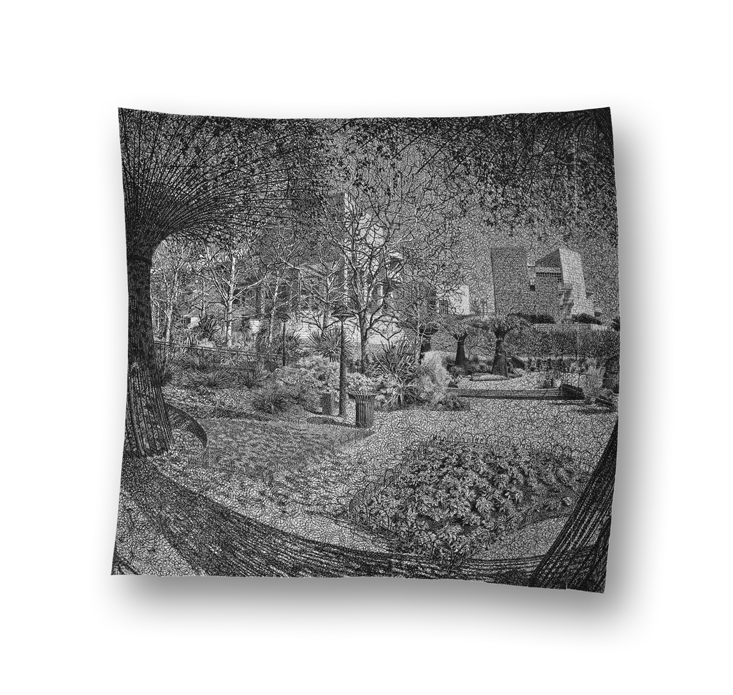
interesting approach to illustrating a complex scientific concept! This October 18, 2023 news item on phys.org describes the measurement problem,
Quantum mechanics is full of weird phenomena, but perhaps none as weird as the role measurement plays in the theory. Since a measurement tends to destroy the “quantumness” of a system, it seems to be the mysterious link between the quantum and classical world. And in a large system of quantum bits of information, known as “qubits,” the effect of measurements can induce dramatically new behavior, even driving the emergence of entirely new phases of quantum information.
This happens when two competing effects come to a head: interactions and measurement. In a quantum system, when the qubits interact with one another, their information becomes shared nonlocally in an “entangled state.” But if you measure the system, the entanglement is destroyed. The battle between measurement and interactions leads to two distinct phases: one where interactions dominate and entanglement is widespread, and one where measurements dominate, and entanglement is suppressed.
…
An October 18, 2023 Google Quantum AI news release, which originated the news item, on EurekAlert provides more information about a research collaboration between Google and Stanford University,
As reported today [October 18, 2023] in the journal Nature, researchers at Google Quantum AI and Stanford University have observed the crossover between these two regimes — known as a “measurement-induced phase transition” — in a system of up to 70 qubits. This is by far the largest system in which measurement-induced effects have been explored. The researchers also saw signatures of a novel form of “quantum teleportation” — in which an unknown quantum state is transferred from one set of qubits to another — that emerges as a result of these measurements. These studies could help inspire new techniques useful for quantum computing.
One can visualize the entanglement in a system of qubits as an intricate web of connections. When we measure an entangled system, the impact it has on the web depends on the strength of the measurement. It could destroy the web completely, or it could snip and prune selected strands of the web, but leave others intact.
To actually see this web of entanglement in an experiment is notoriously challenging. The web itself is invisible, so researchers can only infer its existence by seeing statistical correlations between the measurement outcomes of qubits. Many, many runs of the same experiment are needed to infer the pattern of the web. This and other challenges have plagued past experiments and limited the study of measurement-induced phase transitions to very small system sizes.
To address these challenges, the researchers used a few experimental sleights of hand. First, they rearranged the order of operations so that all the measurements could be made at the end of the experiment, rather than interleaved throughout, thus reducing the complexity of the experiment. Second, they developed a new way to measure certain features of the web with a single “probe” qubit. In this way, they could learn more about the entanglement web from fewer runs of the experiment than had been previously required. Finally, the probe, like all qubits, was susceptible to unwanted noise in the environment. This is normally seen as a bad thing, as noise can disrupt quantum calculations, but the researchers turned this bug into a feature by noting that the probe’s sensitivity to noise depended on the nature of the entanglement web around it. They could therefore use the probe’s noise sensitivity to infer the entanglement of the whole system.
The team first looked at this difference in sensitivity to noise in the two entanglement regimes and found distinctly different behaviors. When measurements dominated over interactions (the “disentangling phase”), the strands of the web remained relatively short. The probe qubit was only sensitive to the noise of its nearest qubits. In contrast, when the measurements were weaker and entanglement was more widespread (the “entangling phase”) the probe was sensitive to noise throughout the entire system. The crossover between these two sharply contrasting behaviors is a signature of the sought-after measurement-induced phase transition.
The team also demonstrated a novel form of quantum teleportation that emerged naturally from the measurements: by measuring all but two distant qubits in a weakly entangled state, stronger entanglement was generated between those two distant qubits. The ability to generate measurement-induced entanglement across long distances enables the teleportation observed in the experiment.
The stability of entanglement against measurements in the entangling phase could inspire new schemes to make quantum computing more robust to noise. The role that measurements play in driving new phases and physical phenomena is also of fundamental interest to physicists. Stanford professor and co-author of the study, Vedika Khemani, says, “Incorporating measurements into dynamics introduces a whole new playground for many-body physics where many fascinating and new types of non-equilibrium phases could be found. We explore a few of these striking and counter-intuitive measurement induced phenomena in this work, but there is much more richness to be discovered in the future.”
Before getting to the citation for and link to the paper, I have an interview with some of the researchers that was written up by Holly Alyssa MacCormick (Associate Director of Public Relations. Science writer and news editor for Stanford School of Humanities and Sciences) in an October 18, 2023 article for Stanford University, Note 1: Some of this will be redundant; Note 2: Links have been removed,
Harnessing the “weirdness” of quantum mechanics to solve practical problems is the long-standing promise of quantum computing. But much like the state of the cat in Erwin Schrödinger’s famous thought experiment, quantum mechanics is still a box of unknowns. Similar to the solid, liquid, and gas phases of matter, the organization of quantum information, too, can assume different phases. Yet unlike the phases of matter we are familiar with in everyday life, the phases of quantum information are much harder to formulate and observe and as a result have been only a theoretical dream until recently.
Measurements are arguably the weirdest facet of quantum mechanics. Intuition tells us that a state has some definite property and measurement reveals that property. However, measurements in quantum mechanics produce intrinsically random results, and the act of measurement irreversibly changes the state itself. Unlike laptops, smartphones, and other classical computers that rely on binary “bits” to code in the state of 0 (off) or 1 (on), quantum computers use “qubits” of information that can be in the state of 0, 1, or 0 and 1 at the same time, a concept known as superposition. The act of measurement doesn’t just extract information, but also changes the state, randomly “collapsing” a superposition into a specific value (0 or 1).
Moreover, this collapse affects not just the qubit that was measured, but also potentially the entire system—an effect described by Einstein as “spooky action at a distance.” This is due to “entanglement,” a quantum property that allows multiple particles in different places to jointly be in superposition, which is a key ingredient for quantum computing. The collapse of an entangled state can also enable spooky phenomena such as “teleportation,” thereby irretrievably altering the “arrow of time” (the concept that time moves in one forward direction) that governs our everyday experience.
In other words, measurements can be used to fundamentally reorganize the structure of quantum information in space and time.
Now, a new collaboration between Stanford and Google Quantum AI investigates the effect of measurements on quantum systems of many particles on Google’s quantum computer and has obtained the largest experimental demonstration of novel measurement-induced phases of quantum information to date. The study was co-led by Jesse Hoke, a physics graduate student and fellow at Stanford’s Quantum Science and Engineering initiative (Q-FARM), Matteo Ippoliti, a former postdoctoral scholar in the Department of Physics, and senior author Vedika Khemani, associate professor of physics at the Stanford School of Humanities and Sciences and Q-FARM. Their results were published Oct. 18 in the journal Nature.
Here, Hoke, Ippoliti, and Khemani discuss how they observed measurement-induced phases of quantum information—a feat once thought to be beyond the realm of what could be achieved in an experiment—and how their new insights could help pave the way for advancements in quantum science and engineering.
Question: What distinguishes the phases investigated in this study from one another, and what is teleportation?
Ippoliti: In the simplest case, there are two phases. In one phase, the structure of quantum information in the system forms a strongly connected web where qubits share a lot of entanglement, even at large spatial distances and/or temporal separations. In the other, the system is weakly connected, so correlations like entanglement decay quickly with distance or time. These are the two phases that we probed in our experiment. The strongly entangled phase enables teleportation, which occurs when the state of one qubit is instantly transmitted, or “teleported,” to another far away qubit by measuring all but those two qubits.
Question: How did you control when a phase transition occurred
Khemani: The competing forces at play are the interactions between qubits, which tend to build entanglement, and measurements of the qubits, which can destroy it. This is the famous “wave function collapse” of quantum mechanics—think of Schrödinger’s cat “collapsing” into one of two states (dead or alive) when we open the box. However, because of entanglement, the collapse is not restricted to the qubit we directly measure but affects the rest of the system too. By controlling the strength or frequency of measurements on the quantum computer, we can induce a phase transition between an entangled phase and a disentangled one.
Question: What were some of the challenges your team needed to overcome to measure quantum states, and how did you do it?
Ippoliti: Measurements in quantum mechanics are inherently random, which makes observing these phases notoriously challenging. This is because every repetition of our experiment produces a different, random-looking quantum state. This is a problem because detecting entanglement (the feature that sets our two phases apart) requires observations on many copies of the same state. To get around this difficulty, we developed a diagnostic that cross-correlates data from the quantum processor with the results of simulations on classical computers. This hybrid quantum-classical diagnostic allowed us to see evidence of the different phases on up to 70 qubits, making this one of the largest digital quantum simulations and experiments to date.
Hoke: Another challenge was that quantum experiments are currently limited by environmental noise. Entanglement is a delicate resource that is easily destroyed by interactions from the outside environment, which is the primary challenge in quantum computing. In our setup, we probe the entanglement structure between the system’s qubits, which is destroyed if the system is not perfectly isolated and instead gets entangled with the surrounding environment. We addressed this challenge by devising a diagnostic that uses noise as a feature rather than a bug—the two phases (weak and strong entanglement) respond to noise in different ways, and we used this as a probe of the phases.
Khemani: In addition, we used the fact that the “arrow of time” loses meaning with measurement-induced teleportation. This allowed us to reorganize the sequence of operations on the quantum computer in advantageous ways to mitigate the effects of noise and to devise new probes of the organization of quantum information in space-time.
Question: What do the findings mean?
Khemani: At the level of fundamental science, our experiments demonstrate new phenomena that extend our familiar concepts of “phase structure.” Instead of thinking of measurements merely as probes, we are now thinking of them as an intrinsic part of quantum dynamics, which can be used to create and manipulate novel quantum correlations. At the level of applications, using measurements to robustly generate structured entanglement is inspiring new ways to make quantum computing more robust against noise. More generally, our understanding of general phases of quantum information and dynamics is still nascent, and many exciting surprises await.
Acknowledgements
Hoke conducted research on this study while working as an intern at Google Quantum AI under the supervision of Xiao Mi and Pedram Roushan. Ippoliti is now an assistant professor of physics at the University of Texas at Austin. Additional co-authors on this study include the Google Quantum AI team and researchers from the University of Massachusetts, Amherst; Auburn University; University of Technology, Sydney; University of California, Riverside; and Columbia University. The full list of authors is available in the Nature paper.
Ippoliti was funded in part by the Gordon and Betty Moore Foundation’s EPiQS Initiative. Khemani was funded by the U.S. Department of Energy, Office of Science, Basic Energy Sciences; the Alfred P. Sloan Foundation; and the Packard Foundation.
Here’s a link to and a citation for the paper, Note: There are well over 100 contributors to the paper and I have not listed each one separately, You can find the list if you go to the Nature paper and click on Google Quantum AI and Collaborators in the author field,
Measurement-induced entanglement and teleportation on a noisy quantum processor by Google Quantum AI and Collaborators. Nature volume 622, pages 481–486 (2023) DOI: https://doi.org/10.1038/s41586-023-06505-7 Published online: 18 October 2023 Issue Date: 19 October 2023
This paper is open access.



